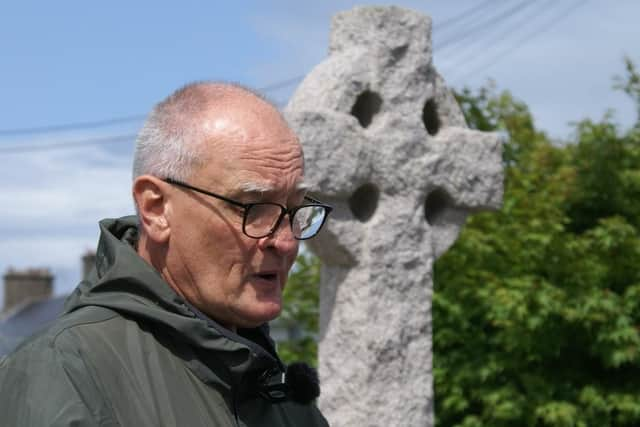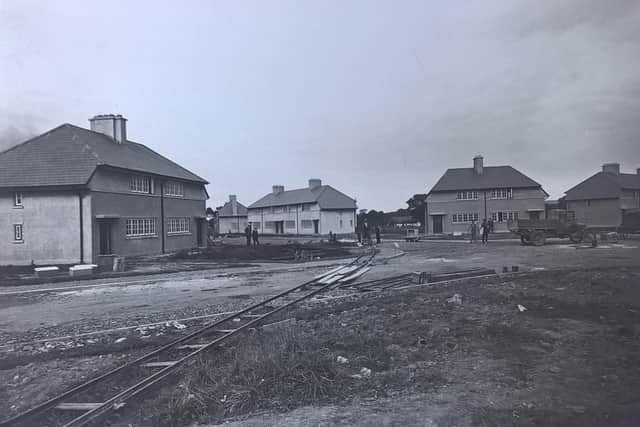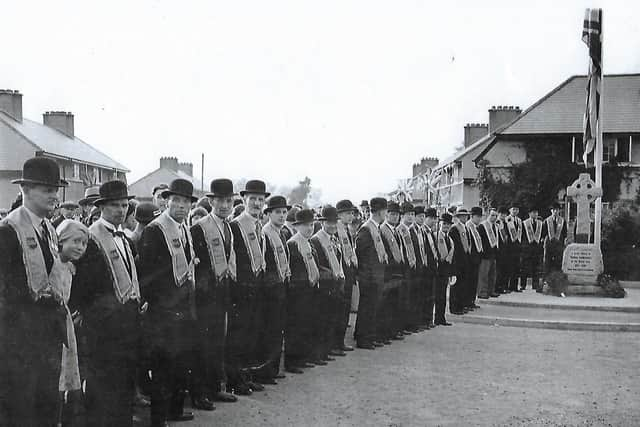They returned from horrific warfare to houses for heroes
Also called cottages or ‘homes for heroes’ and built in groups or colonies, over 2,700 were constructed throughout Ireland after WWI.
Nigel has documented around 1,252 in Northern Ireland[1], built between 1921 and 1939, with details of the first occupants. He recently led a History Hub Ulster[2] walking tour around a 17-acre colony with 146 dwellings off Belfast’s Cregagh Road. It was completed in 1925 and is Ulster’s largest colony.
Dublin’s Killester colony is the largest in Ireland north and south, with 289 dwellings.

 Nigel Henderson recounts WWI Heroes at Cregagh War Memorial
Nigel Henderson recounts WWI Heroes at Cregagh War Memorial
Excepting one, the Cregagh colony’s streets are named after six of France’s historic WWI battlefields - Thiepval, Bapaume and Picardy Avenues, and Hamel, Albert and Somme Drives.
Bell’s Lane wasn’t named after a battlefield but was renamed Montgomery Road after a very famous British Field Marshal.
Belfast photographer Alexander Hogg captured the construction of the colony in pictures, one showing mini rail tracks for transporting building materials.
He also photographed a steam engine breaking up rocks and some local youngsters posed for his camera on an unfinished footpath.

 Hogg photographed Railway in 1925 (PRONI)
Hogg photographed Railway in 1925 (PRONI)
The Cregagh District War Memorial stands at the junction of Thiepval, Bapaume and Picardy Avenues, where Hogg photographed the mini railway.
A newspaper reported 2,000 people gathered here on 10th November 1929 for the unveiling of a Celtic Cross commemorating those from the Cregagh District who fell in WWI.
Another photo of the memorial, circa 1930s, shows a line-up of members of the Cregagh Defenders Loyal Orange Lodge at a remembrance event.
Nigel paused in each street in the colony to describe house layouts and to focus on some WWI veterans who’d lived there.

 Cregagh Defenders lodge and little girl at a 1930s Remembrance event
Cregagh Defenders lodge and little girl at a 1930s Remembrance event
Most homes have been altered or extended, but initially there were three house types, differing slightly in floor area.
Either semi-detached or in blocks of four, each property averaged 0.12 acres, some with a driveway.
Each had a downstairs living room, scullery/kitchen, larder and fuel store.
They all had a bathroom, separate WC and three upstairs bedrooms.
Not bad for ten shillings a week (about £30 today) though rents were kept artificially low.
A house directly behind the war memorial was home to former Belfast Corporation gas worker Adam Hamilton who enlisted with the Royal Irish Rifles.
The story that Nigel shared outside Adam’s house very vividly illustrated why these are called ‘homes for heroes’.
Adam sustained gunshot wounds to the throat and neck in France in July 1918 and was admitted to a Casualty Clearing Station and then a base hospital.
He was evacuated by hospital ship to the UK and was serving with a Reserve Battalion in September 1918 when an X-Ray showed shrapnel still embedded in the base of his tongue.
An operation was too risky.
Adam was discharged with a pension and lived with his wife Grace in their Cregagh home.
Nigel recounted numerous heroic tales like Adam’s.
Former shipyard rivet-heater Edwin Bothwell in Thiepval Avenue served with the Labour Corps in France and was discharged due to wounds in December 1917, aged 25.
Edwin was awarded a Silver War Badge.
Former shipyard worker and then tram driver Leslie Hammond lived in Bapaume Avenue.
He’d enlisted with the Royal Navy in 1915 and was serving on HMS Diligence when he was demobilised in 1919.
Private Thomas Foreman from Thiepval Avenue enlisted in 1916 and was with a North Irish Horse Battalion when he was injured and taken prisoner in 1918 during the German Spring Offensive.
Thomas survived three German POW camps before settling in Thiepval Avenue with his wife Mary and a Silver War Badge.
Tram Inspector William Harvey in Somme Drive served in military transport on the Western Front from October 1915 to December 1917 and then in Army Reserve until 1919.
He had a Disability Pension for deafness, probably from shellfire on the front lines.
Joseph Mackey of Picardy Avenue was a stoker with the Royal Navy. Lance Sergeant Albert Gribben of Hamel Drive was discharged due to blindness. Royal Engineer Sergeant Robert Foulis in Albert Drive was severely shell-shocked in France.
Every house is a condensed history of The Great War.
There’ll be another History Hub Ulster walking tour later this year led by Nigel Henderson in the Earl Haig Colony on Belfast’s Lower Cregagh Road. Details will be at historyhubulster.co.uk
References
- ^ Northern Ireland (www.newsletter.co.uk)
- ^ History Hub Ulster (www.newsletter.co.uk)